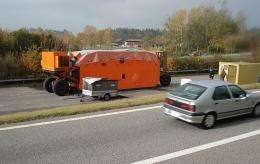Clean streets and intact road surfaces help to keep the air clean

Road traffic is one of the main sources of fine particulate matter in the atmosphere, above all when the weather situation favors the creation of winter smog, as has been the case over the past few day in the Swiss “Mittelland”. Vehicle tailpipe emissions are responsible for just less than half of the fine particles, however. The majority of this pollutant is produced by mechanical wear and resuspension of dust due to air turbulence from passing vehicles, as a study by atmospheric specialists from Empa and PSI has shown.
The quality of our air has significantly improved over the past decades. However, the high level of pollutants in the air during episodes of winter smog remains a problem. Favorable conditions for winter smog episodes occur during so-called temperature inversions. In these typically windless high-pressure zones, a layer of warm air lies above cold air near to the ground with no mixing between the two. The fine particle matter released by combustion processes, and mechanical wear, and that thrown up again swirling air can no longer move into the higher layers of the atmosphere, with the result that the concentration at ground level increases.
Fine particles from road wear and turbulence
In towns, wear debris from vehicle brakes, tires, and the road surface itself, as well as the resuspension of "normal" dust, are responsible for more than half the fine particle emissions due to road traffic. Scientists from Empa's Air Pollution & Environmental Technology Laboratory had already shown this in an earlier research project. What remained unclear, though, was how much the individual processes contributed to the total emissions, since road surface wear debris and road dust have similar chemical compositions, consisting primarily of mineral particles with diameters between 2.5 and 10 micrometers. The researchers therefore first had to find a way of assigning emissions to their sources.
In solving this problem, the interdisciplinary nature of Empa’s activities proved to be a trump card. Working together with the Road Engineering / Sealing Components Laboratory, the atmospheric specialists developed a new measuring method using Empa's Traffic Load Simulator. This machine is normally used to investigate the time-accelerated resistance to wear of road surfaces under extreme load conditions.

Road wear: the quality of the surface is decisive
The results of a recently completed project, which was financially supported by the Swiss Federal Offices for Roads (FEDRO) and for the Environment (FOEN), show that in urban areas wear debris from vehicle brakes contributes about 20% of the fine particle emissions from road traffic because of the stop and go nature of traffic flow. Particulate matter due to tire wear, on the other hand, was hardly significant.
In this situation the state of repair of the road plays a decisive role. If the road surface is intact, then emissions due to direct road wear remain at low levels. Damaged roads surfaces, on the other hand, can result in quite high fine particle emission levels. As far as the resuspension of fine particulate matter due to air turbulence is concerned, the level is determined primarily by how dirty the road surface is – if it is dirty, then this becomes the dominating factor. And finally, the characteristics of the road surface also have an influence on fine particle emissions. With the porous road surfaces which are often used today (because they reduce noise and have favorable properties in rainy conditions) the quantity of resuspended particle matter was significantly less than that encountered on compact road surfaces. Whether this is also true when porous surfaces age and their pores may become blocked remains an open question.
What this means is that keeping roads as clean as possible and in good repair makes a significant contribution to reducing the problem of fine particulate emissions.
Provided by EMPA
















